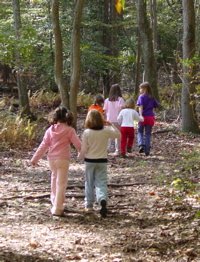Health and Physical Education
for the Earth
The health and physical education curriculum offers opportunities for integrating an environmental ethic, sustainability learning, and an understanding of our connection with the rest of Nature into an area of teaching that many educators (and sports fans)
don't see as related.

Physical education and health classes can readily incorporate environmental education. In physical education, we can explore activities such as hiking, orienteering, bicycling, archery, and skiing that offer both opportunities to stay fit and incentives to be good stewards of the natural world.
— Minnesota Department of Natural Resources
Once we start thinking about greening all aspects of the curriculum, it begins to make sense that health and physical education can be viewed through an environmental and sustainability lens.
"Come on, kids. It's a beautiful day today. Let's go outside for our gym class and enjoy this wonderful weather," is the easiest way to shift the context of physical education slightly, so that it's also about the Earth. When we think health and physical education, we should be thinking "outdoor education" as much as possible.

Another easy shift happens when we realize that, quite often, environmentally friendly lifestyle choices contribute to fitness levels (for example, walking or bicycling to school rather than being driven).
If you can choose the focus in your physical education classes, emphasize individual (environmentally friendly) fitness activities and outdoor recreation opportunities more than team sports that most students will never play as adults. (Your more athletic students will join intramural or extracurricular teams and have plenty of time to practise their skills and play competitively.)
Take your students on field trips to local parks — introduce them to the outdoor recreation opportunities near their home.
Health and physical education is probably the best class in which to teach about children's environmental health issues and rights.
For fun and active environmental education (or to introduce your new students to your school's recycling system), hold an Environmental Field Day — including recycling relays and other stations where students combine physical movement with environmental learning (for example, predator and prey games).

The good news is, healthy kids and a healthy environment are closely intertwined. Efforts to help children understand and appreciate the natural environment often involve physical activities. Environmental education in areas such as water and air quality form a natural bridge to discussions of personal and public health.... Our children need life lessons on keeping the world around them healthy for themselves and other living things.
— Minnesota Department of Natural Resources
Health and physical education teachers can contribute to transformative sustainability education by helping their students
- simply get outdoors more!
- learn about environmental aspects of personal safety, injury prevention, and sports performance (for example, sun safety and weather awareness, smog alerts and health, heat island effect)
- become aware of the potential impacts of environmental toxins on their health (and perhaps how to lobby for cleaner air)
- understand the concept and some specific examples of environmental children's health — how growing bodies are especially vulnerable to environmental problems (for example, children's lungs have a higher respiration rate than adult lungs, so they are more affected by air pollution)
- in a sexual and reproductive health unit, learn about endocrine disruptors, their effects, and how to keep them out of the environment and out of their bodies
- examine competition versus cooperation, in sport and in life, and learn team-building skills
- discover their ecological self and an eco-identity as part of developing a positive sense of self
- learn the importance to their health (physical, mental and spiritual) of personal connections with the rest of Nature
- recognize that a connection to the natural world is a sign of emotional health as well as a strategy for mental health (for example, Nature as stress reducer, as a site for meditation, as an opportunity for time/space alone)
- learn the importance of connecting with the world outdoors (gardening, Nature sketching, quiet contemplation, "heart spots" in the natural world)
- learn the rules of the road for bicyclists
- combine fitness with environmental friendliness (for example, walking or biking to school instead of being driven)
- make environmental friendliness one of their criteria for choosing a recreational activity
- become mindful of the impacts of their sporting and recreational activities (for example, through carbon neutral tournaments, participating closer to home to cut down on greenhouse gas emissions, leaving sports fields litter-free after games and practices)
- examine the pervasiveness of violence against Nature (as a worldview), and its relationship to violence against women and children in some societies
- understand peer pressure as it relates to fostering sustainable behaviours and lifestyle choices
- learn vegetarian/vegan nutrition facts and dietary principles, as well as the environmental and health benefits of eating low on the food chain, and eating organic and locally grown foods to cut down on greenhouse gas emissions and improve personal health
Return from Health and Physical Education for the Earth to Integration
Go to GreenHeart Education Homepage